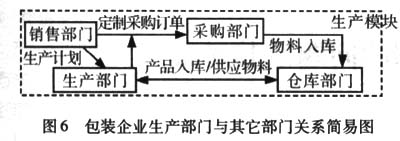1.1.3 Analysis of Production Module
The above mentioned some of the responsibilities of the production department. In the market economy, packaging companies must produce according to market demand. Production exists between procurement, sales, and inventory. Flowing around production is logistics.
The function of the production department is not only limited to organizational production, but also has other functions. The primary task of the packaging company's production management department is to formulate production processes, produce products, and store products. What kind of product, quantity, etc. should be produced according to the production plan of the sales department. When the production department needs logistics, it must formulate a procurement plan to the procurement department and then the warehouse. The relationship between the production department and each department is shown in Figure 6.

1.1.4 Inventory Module Analysis
The packaging company's inventory department is a passive and unauthorised department and has a relationship with the purchasing, sales, production departments, vendors, and customers. Stored in the warehouse are mainly materials and products. The relationship between the inventory department and other departments can be seen in the above introduction.
1.1.5 analysis of customers and suppliers module
From the above module diagram, it can be seen that customers and suppliers are external users in the packaging company ERP system. As a supplier of commercial products to access this system, you can understand the order, contact, confirmation and supply of the purchasing department. The supplier can be divided into different types and evaluation levels. As a customer user logging in the system, you can learn more about the company's products and services, and contact the sales department to order.
1.1.6 Analysis of Financial Module
The packaging company ERP financial management embodies the value flow and runs through all aspects of the packaging company's supply chain management. The relationship between the financial management module has been shown in the above diagram, and the financial management is also responsible for the functions such as employee wage expenditure, management of the cost of funds, borrowing, reimbursement, daily income and expenditure.
1.1.7 Analysis of Other Modules
The equipment management of the packaged ERP system mainly includes basic equipment information management, equipment introduction and purchase, and equipment depreciation. The introduction of equipment is carried out by the planning department. The personnel module management mainly includes personnel basic information management, personnel introduction, personnel training management, personnel promotion, personnel dismissal, and personnel wages payment standard management. For details of the functions of these modules, see References Packaging Enterprise ERP System. The back-end management module maintains the normal operation of the system. It mainly completes the configuration and maintenance of authorities, departments, and users. This module is operated by a background administrator.
2 Realization of Packaging Enterprise ERP System
The packaging company's various departments collaborated around the core management of the supply chain to enable the coordinated operation of internal and external logistics, information flow, and capital flow, and optimize the allocation of resources. The overall system of all streaming components is based on a network, hardware and software-based environment. Its overall system can also be called a virtual packaging company.
2.1 Model Implementation Techniques and Models
Based on the above analysis, the packaging company ERP system is a typical multi-use network system, different production has different rights and access content, the network system can use B / S (browser / server) mode. Software system development can be developed using ASP, Javascript, C++Builder, Java Applet technology and tools.
Internal intranets are set up within the company. Intranets are also external to the company. Each intranet product can access its own module through the intranet. External customers and suppliers can access their respective modules through an extranet. , but share a database, using SQL Server database. The specific implementation mode is shown in Figure 7.

2,2 System Database Design
The packaging company ERP system database reflects the integration of various modules. Some data is shared between each module. The relationship between the various applications directly reflects the relationship between the tables in the database. The database uses the SQL Server database. The main tables are: department table (recording information of each department), permission table (recording user privilege level information), user table, supplier or customer table, purchase order form, warehousing form, and after-sales service Information table, outbound order form, purchase schedule, product type table, production schedule, sales order form, equipment table, expense list, reimbursement information table, loan table, credit information table, income statement information table, expense information table , A detailed list of expenditures by installments and a statement of the installment of payments by installments.
3 Conclusion
This paper designs and implements the packaging company ERP system, analyzes each module around the supply chain in detail, introduces their functions, and realizes the functions of the core supply chain management modules. There is still a long way to go before applying the ERP system to the actual packaging companies. The above is only the prototype of the packaging enterprise ERP system.
(Author/Sun Deqiang Cao Lijie Xi'an University of Technology)
Packaging Engineering
Saddle Pad,Circle Y Saddle Pad,Western Saddle Pad,English Saddle Pads
NINGBO BRIGHT MAX CO., LTD. , https://www.brightmax-equine.com